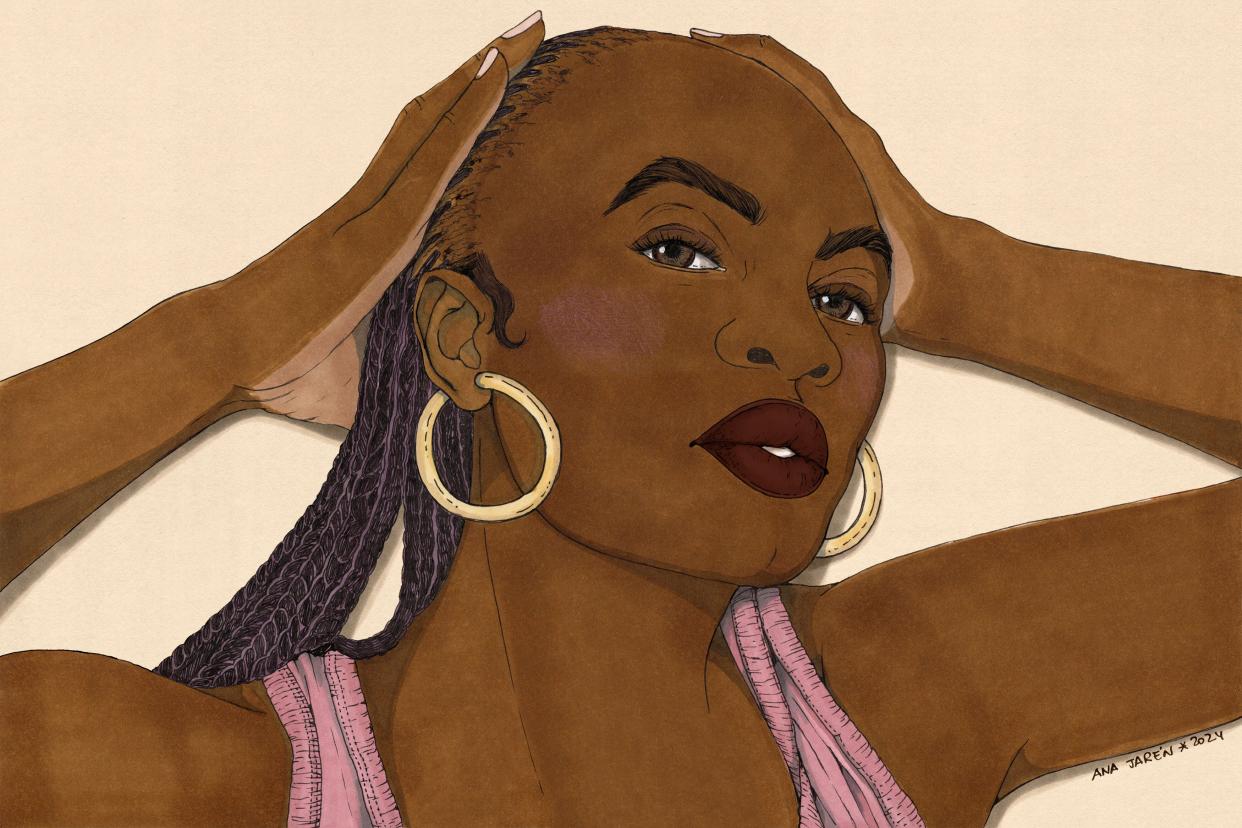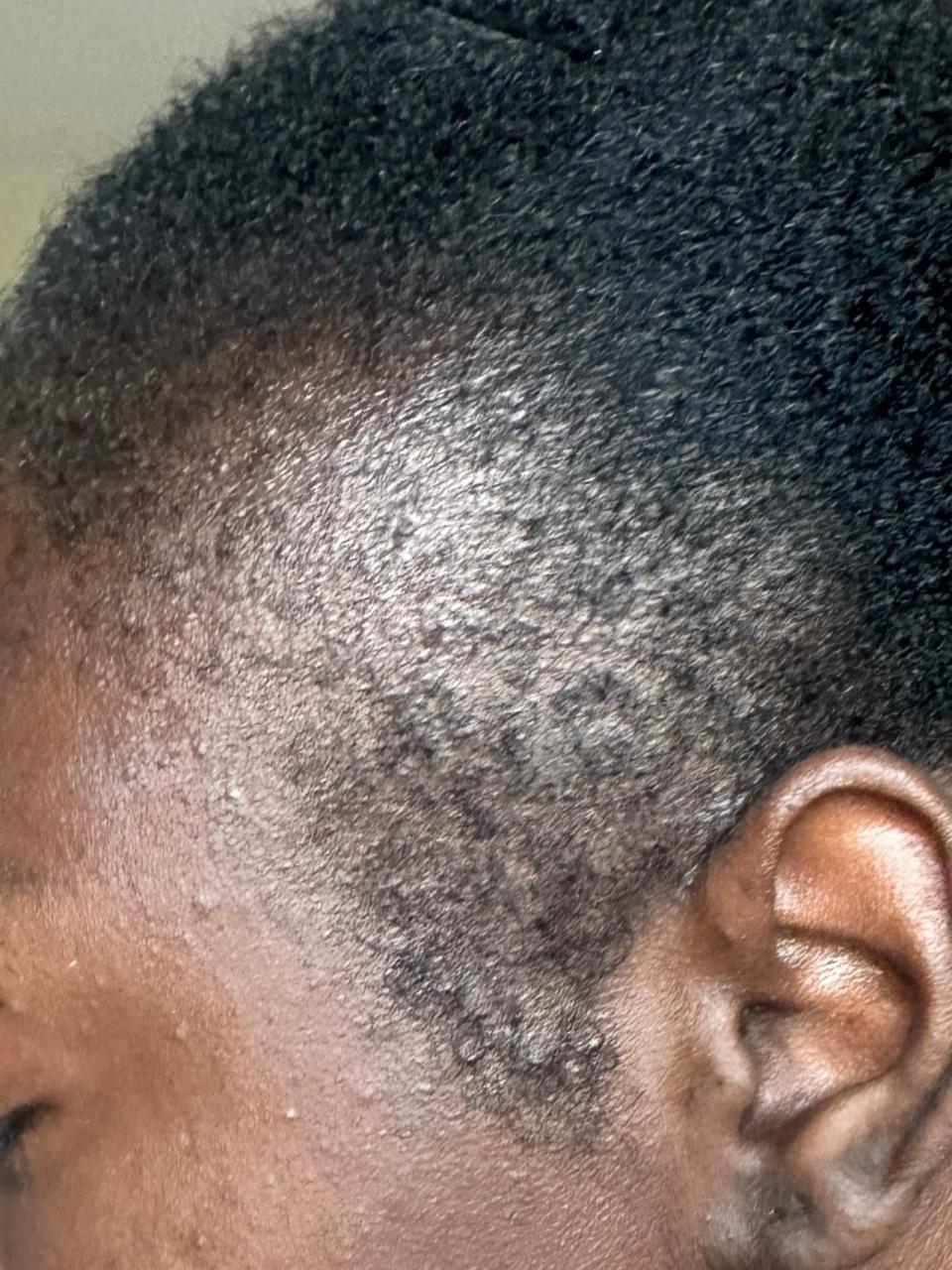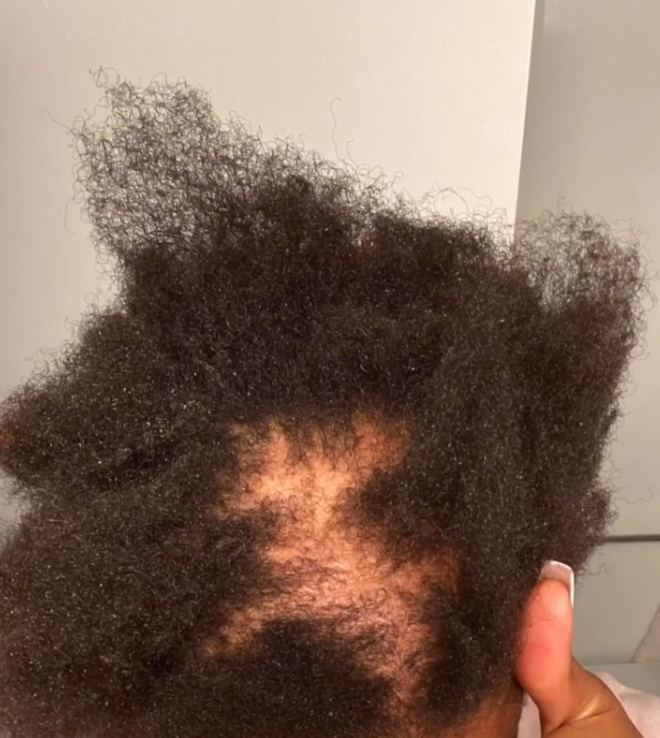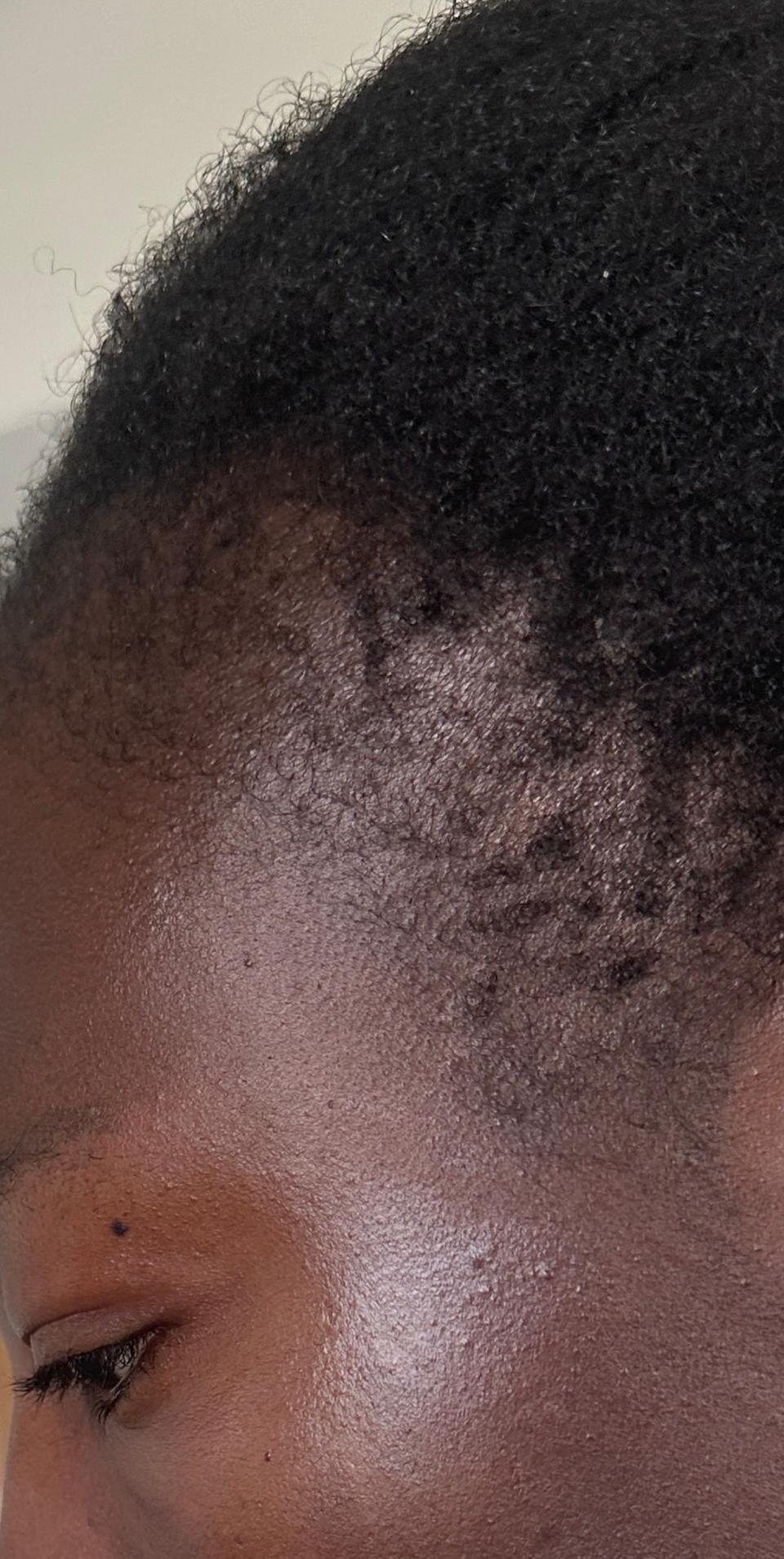For Black Women, Traction Alopecia Costs Us More Than Our Hair

Ana Jarén
Welcome to It’s Textured, a monthly column where we untangle the joy, trauma, confusion, and frustration that can come with Black hair. This month, associate beauty editor Annie Blay speaks with three women about their journey with traction alopecia and how their hair loss helped them gain so much more in the end.
That’s weird, 29-year-old Drea Okeke thought as she examined her new set of box braids. No stranger to protective styles, Okeke was used to seeing evenly spaced parts between her braids, but this time, something was off. Getting a fresh set of braids was usually a liberating feeling for the content creator, but the relief of not having to do her hair for at least three weeks was replaced by a tinge of worry as she noticed the unusually large spaces between her box braids.
Like many Black women, this writer included, braids are a normal part of Okeke’s hair routine—or at least they were. As a first-generation Nigerian, getting her hair braided was practically a birthright. “My aunt has a hair-braiding salon in Queens, so [in my teen years] I used to get my braids for free,” Okeke says. And since it was free, she’d get those braids often, going back and forth between box braids, sew-in weaves, and crochet styles (her favorite)—all meant to be “protective” because they kept her strands tucked away.
In her college years, weaves were the style du jour. “When I got a weave I’d keep it in for as long as I could,” says Okeke. But all that repetitive tension on the scalp proved harmful over time. Patches of her hair began to fall out, eventually revealing a humbling diagnosis: traction alopecia. “It started at the top of my head, mostly around the left side,” Okeke says. “It started with one patch then grew to more and more.”
Traction alopecia is a form of hair loss caused by prolonged tension on the scalp. Symptoms include tenderness and pain on the scalp and pimple-like bumps in the areas of highest tension. “Traction alopecia is caused by anything that pulls on the hair, ultimately damaging the root, and can lead to scarring and permanent hair loss,” board-certified dermatologist Doris Day, MD, previously told Allure.
The condition typically starts at the hairline, but in certain cases can begin on other parts of the head, like the back or the sides as it did for Okeke. “It's a process that usually takes years,” Dr. Day said. For Okeke, it took about four years before she began noticing the patches at the top of her hair in 2020. "I thought it wasn’t a big deal at the time and that it would grow back,” she says—a thought many Black women have mistakenly believed.
When Ashley Parker first noticed her edges becoming thin, she thought nothing of it either—because she was instructed to. “I was getting my hair done at the salon and they had just relaxed it and my edges were coming out in chunks,” says Parker (who is using a pseudonym for this story). “I was so worried but the hairdresser was like, 'Don't worry. It'll grow back.'” Just a few hours after getting the relaxer, Parker got box braids. The now 22-year-old architecture student had been getting braids since she was in boarding school in England, starting at aged 10. “It's difficult to maintain your natural hair while you're in boarding school so I would get my hair braided [in a style that lasted] for four weeks at a time,” says Parker. When she removed the braids a few weeks after the appointment where her hair was falling out, she realized her edges had gone from thin to nonexistent.
Traction alopecia can affect people of any ethnicity, but is most commonly seen in Black women. Up to a third of us will have the condition, according to a 2023 article published in the journal JAMA Dermatology. While there’s been a recent increase in information and awareness about TA among dermatologists and hairstylists, Black women dealing with the condition often do so in isolation with feelings of shame and helplessness that can’t be improved in a doctor’s office or with different hairstyles.
Thinning edges are not normal
The thought of it at its worst (large patches of hair falling out) is terrifying to most, but the beginnings of traction alopecia (thinning edges) are almost universally Black. Crystal Aguh, MD, a board-certified dermatologist in Baltimore, says she believes most people are familiar with the concept of traction alopecia, even if they don’t know the medical term for the condition.
“Part of the struggle is calling them ‘protective’ styles. Let's call them styles of convenience because that's what they really are.”
If you often got braids while you were growing up, you were probably advised to “not get braids too tight” or “give your hair breaks” in between styles. But Dr. Aguh says that in terms of guaranteeing you won’t lose your hair, these tips are more or less old wives' tales. “Hairstyles don't have to be tight for you to develop traction alopecia,” says Dr. Aguh. The molecular science of hair follicles doesn’t abide by our human understanding of what feels like it might be “too tight.” Dr. Aguh explains that if you’ve begun to experience hair loss due to tension, then any hairstyle (including glue-on wigs, sew-ins, and locs) that perpetuates that tension over a prolonged period could lead to further hair loss. “Part of the struggle is calling them ‘protective’ styles,” says Dr. Aguh. “Let's call them styles of convenience because that's what they really are." While Dr. Aguh confirms these styles may protect hair from the breakage that can come from constant manipulation, they can also introduce damage from tension on the scalp.
In treating her many Black patients who deal with traction alopecia, Dr. Aguh finds that one of the biggest barriers to understanding TA and treating it is a lack of education directly related to the lack of diversity in dermatology. “Because of the limited literature on Black hairstyling methods, hair loss in this patient population can present a diagnostic and therapeutic challenge for dermatologists,” Dr. Aguh wrote in a review for the Journal of the American Academy of Dermatology. While a dermatologist of any race can understand the science behind traction alopecia, many lack the cultural awareness to empathize and sometimes properly treat the condition in Black women.
This is exactly what 23-year-old Nyana Martin faced. After two years of wearing locs (a decision she made because she thought it would help her hair grow), an area in the back of Martin’s head finally gave out from strenuous hairstyles. “I would do pinups a lot,” says Martin, referencing a style involves gathering locs at the top of the head by twisting them from the bottom up. “It felt really tight from a mix of the twisted locs and bobby pins. I never kept the pinups in for long because they hurt,” says Martin. “I could maybe give them maybe four or five days max because they would hurt that much.”
When Martin’s hair began to fall out in the back, it came out unevenly. The hair was slow to grow and when the uneven growth began to “look all over the place,” Martin cut the hair in the area and rocked an undercut. Like Okeke and Parker, Martin wasn’t too concerned at first; she felt that wearing an undercut was an edgy fix. ”I don't think I really cared much about it until it wasn't growing back,” Martin says.
While the slow progress in her hair growth was frustrating, Martin says that finding a dermatologist who truly understood what she was going through was more troubling. “I remember there was one white dermatologist who asked if there were bumps in the area because if so, there's probably just hair stuck under my scalp,” says Martin. Another derm told Martin to “just take better care of your hair," without giving any specific recommendations beyond moisturizing it more. Martin even underwent hormone testing on the advice of a dermatologist to determine if this was a hormonal issue. It wasn’t.
When traction alopecia affects mental health
Going from one derm to another, Martin felt gaslit—and not just by medical professionals. “Everyone around me was like, ‘Well, just stop touching it. Maybe it's falling out because you keep touching it,’" says Martin.
It’s common in the Black community to pass down ancient hair traditions as modern-day fixes. After all, it worked for our grannies and their grandmothers, so it’s good enough for us. These solutions often include using ingredients like shea butter and most recently a boom in using botanical oils (castor and rosemary oil are the most popular) most of which have limited, if any, evidence that they actually work to reverse hair loss on their own. There’s also the treatment that my mother loved to use: “Just leave it alone.” Comments like these, which imply that the women experiencing the issue are the ones at fault, are, at best, extremely unhelpful. When women facing traction alopecia require more involved treatments, they’re often met with remarks that diminish their experience and amplify the shame they’re already feeling. “My mother was in complete denial that there was anything wrong when my hair started falling out,” says Parker. “She thought that I just developed this complex overnight.”
In reality, effectively treating traction alopecia requires consistently using medication like minoxidil—a method Dr. Aguh advocates for. Parker started to self-treat her traction alopecia in November 2023 using botanical oils but it wasn’t until June 2024 that she actually made a dermatology appointment. “I did a lot of intense research on dermatologists and trichologists, but I was mostly worried about—and I know it sounds ridiculous because it's a doctor's job—getting judged,” says Parker.
Hair is so personal to Black women—especially when we’re losing it.
When she started minoxidil on her derm’s recommendation, her mother urged her to stop “putting this chemical on you.” It put a strain on their relationship for some time until Parker’s mother came with her to a dermatologist appointment and began to understand what was required to treat the condition. Unlike other types of alopecia that are genetic or completely uncontrollable, traction alopecia is, in large part, due to a person’s hair practices and can bring about a feeling of guilt. “I just kept on asking myself, How did I let it get this bad? How did I not notice it on time? I felt like it was my fault, so I needed to fix it,” says Parker.
Another factor that kept her out of the doctor’s office for so long was how difficult it was to find a Black female dermatologist in London where Parker currently lives. (Allure wasn't able to confirm the exact number of Black female dermatologists in England, but if it's anything like the U.S., the ratio is likely low.). “I did not want to go to one that wasn't a Black woman because I felt that they would not understand,” says Parker. Hair is so personal to Black women—especially when we’re losing it. Our strands are already regularly scrutinized and ridiculed, so much so that many Black women would rather avoid seeking medical treatment than risk being shamed by a medical professional who doesn’t understand their hair. “It's more comforting to know that the person who's treating me understands my hair,” says Parker.

Traction Alopecia in Black Women
The same guilt and fear of judgment that kept Parker out of the derm’s office for over a year also pushed her to hide her hair loss from the people close to her. Eventually, this isolation drove her to depression. Losing your hair can be mentally consuming. Parker found it hard to focus on anything else. Her studies for her master’s program and her social life took a hit at the height of her traction alopecia. “There were some days I was so depressed about my hair, about not seeing progress, that I just didn't want to do anything,” Parker says. “I didn’t have the motivation to do anything, go anywhere. I was so depressed about the state of it.”
She tried wigs and different means of covering her natural hair, but nothing made her feel better. Okeke also recalls feeling “embarrassed, awkward, and insecure.” When her hair loss was at its worst in 2020, the content creator harnessed her ability to put on a cheery disposition, smiling and laughing her way through social interactions, but internally she was more self-conscious than ever. She had edgy black and red braids at one point and tried wearing them in different styles to hide the patches, but the braids made her scalp so tender that doing anything other than leaving them down caused pain.

Traction Alopecia in Black Women
Healing through traction alopecia
For Martin, Okeke, and Parker, treating traction alopecia involved more than just growing their hair back. All three women said they had to face the root causes that drove them to constantly keep their hair in protective styles. Many Black women love the look and ease of braids, locs, and weaves, and it is possible to wear these styles while still maintaining healthy natural hair. “Black women in general, just love showing out,” says Okeke. “It’s a cultural thing. We need to look good and our hairstyles are art. You can tell our personality from our hairstyle. If we got a bob, we’re feeling like a boss. If it’s a long buss-down wig, we're ready to go out.” Different hairstyles allow us to express ourselves.
Braids were not just a way to avoid having to do my hair, but to avoid having to look at my hair too.
On a darker flip side, many Black women turn to these styles as a means to hide a part of themselves. Parker recalls thinking that her hair was a problem she had to deal with, often by way of protective styling. She says she thought of her hair as “something I have to get out of the way.” Despite strides toward texture inclusivity made during the first decade of the 2000s natural hair movement, there’s still an underlying sentiment that there’s good hair and bad hair—the latter being coarse, type four hair. I’ve always struggled to love my 4C hair. Very early on in my hair journey, I latched onto the lie that my hair was tough, too hard to do, and ugly. Braids were not just a way to avoid having to do my hair, but to avoid having to look at my hair too.
Since I didn’t see my hair as beautiful, I didn’t value it enough to stop and wonder what constant protective styling was doing to it. “There's this societal perception that our hair, the way that it is, is just not cute,” says Okeke. “We push ourselves to these extremes. It's like, Okay, yeah, my hair is thinning and falling out. But I'm still going to get braids.”
To grow their hair back, all three women I spoke to eventually cut out protective styles entirely. “I made a decision like, Drea, you’ve got to take care of this,” says Okeke. The decision included a break from braids, working with a stylist who specializes in textured hair, and a change in diet. “Before all this happened, I didn't want to even look at my hair,” adds Okeke. “Once I started looking at myself in the mirror with my natural hair, I was able to start loving my hair more. Now, I care for my hair...I love the way I look, wig or no wig.”
Some with traction alopecia eventually may be able to reincorporate protective styling back into their routine. In March 2023, Okeke began experimenting with braids again, but this time she sought the help of braider Aicha Kamara in Elizabeth, New Jersey, who works with many clients who have alopecia to safely reintroduce protective styles.
“Get diagnosed and quickly. Don't do what I did. Go to a dermatologist, find one you trust, and get diagnosed.”
Parker is still steering clear of protective styles during her treatment. She’s currently working with a derm and is on a treatment plan that includes minoxidil, rosemary oil, a derma pen for deeper penetration, and platelet-rich plasma (PRP) injections once every two months. “I went from not thinking about my hair at all to it being something that consumes my entire life,” says Parker. “It’s the first thing I think about when I wake up, the last thing before I go to bed. I’m taking progress pictures obsessively to track and see what’s going on.” Parker’s biggest piece of advice to Black women in a similar position is to “get diagnosed and quickly. Don't do what I did. Go to a dermatologist, find one you trust, and get diagnosed.”

Martin (whose hair loss was not as drastic as the other two women) has taken a more lax approach. “I'm not even focused on growth. I'm focused more on maintenance,” says Martin. This means getting braids less frequently. She recently got braids for the first time in almost two years and when I spoke to her over Zoom in June 2024, she had twists but says she told the braider to keep them “very loose” at the roots. Martin is also using caffeine oil and rice water in her hair-care routine and doing regular scalp massages to promote stimulation and blood circulation.
The most laborious part of treating traction alopecia is tending to the internal wounds it exposes.
Though treatment will likely involve countless derm visits and a tedious product routine, it seems the most laborious part of treating traction alopecia is tending to the internal wounds it exposes—and learning from them. “Practice radical self-acceptance. It's going to be really difficult at first, but I'm way better for it in the long run,” says Parker.
After processing these women’s stories and thinking back on my hair journey, the words from Parker rang loudest: “Listen to your hair. If it hurts, take it out. You're not tender-headed. You don't have to just suck it up.”
Read more stories about hair loss in Black Women:
These Doctors Are Making Hair Transplants More Accessible for Black Patients
Your Favorite Protective Style Might Actually Be Causing Your Hair Loss
Now, watch Tyla get ready for the Met Gala:
Originally Appeared on Allure


